I finished the Airfix Fairey Battle from the "Victoria Cross Icons" set, but before I post photos of the model, I'ld like to pay tribute to the aircrew who gave their lives earning their place among the VC icons.
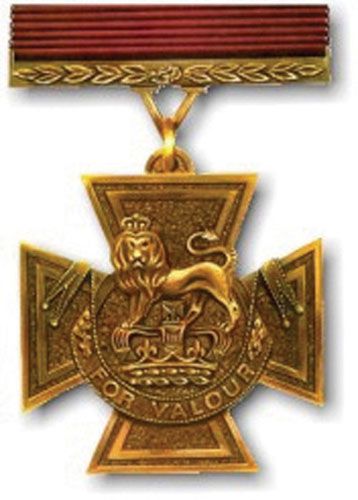
The Fairey Battle represents the aircraft from 12 Squadron, flown on 12 May, 1940, by Flying Officer Donald Edward Garland with observer Sergeant Thomas Gray, when they earned the Victoria Cross. A third crewman, Leading Aircraftsman Lawrence R. Reynolds, received no honors.
Flying Officer Garland was born in Ballincor, Ireland, on 28 June, 1918. He joined the Royal Air Force in 1937.
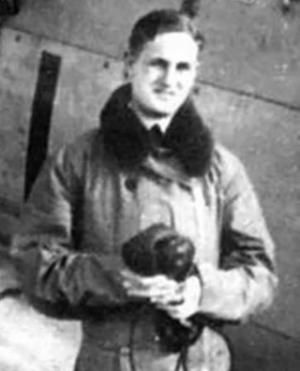
Sergeant Gray was born in Urchfont, England, on 17 May, 1914, and joined the RAF in 1929.

Leading Aircraftsman Reynolds came from Onslow Village, Guildford, Surrey, and was 20 years old at the time of the mission.

The Germans had launched their blitzkrieg in the west, on 10 May, 1940, attacking into France and the low countries. Wehrmacht troops were using two bridges to cross the Albert Canal in Belgium at Veldwezelt and Vroenhoven. Five Fairey Battles from the Advanced Air Striking Force were ordered to take out the bridge at Veldwezelt at all costs. By that time, the area was heavily defended by anti-aircraft emplacements, machine guns and Luftwaffe fighters. Flying Officer Garland was detailed to lead the attack, with Sergeant Gray acting as navigator. All the aircrew in 12 Squadron volunteered to undertake the mission, so the five crews dispatched were finally selected by drawing lots.
The assault on the bridges was to take place at minimum altitude to achieve decisive results, and was met with a withering barrage of gunfire when the Battles dived bombed. Nearby RAF fighters reported that the bridge was obscured by the bomb strikes on the bridge and around it. Although damaged, the bridge was not completely destroyed and was still serviceable.
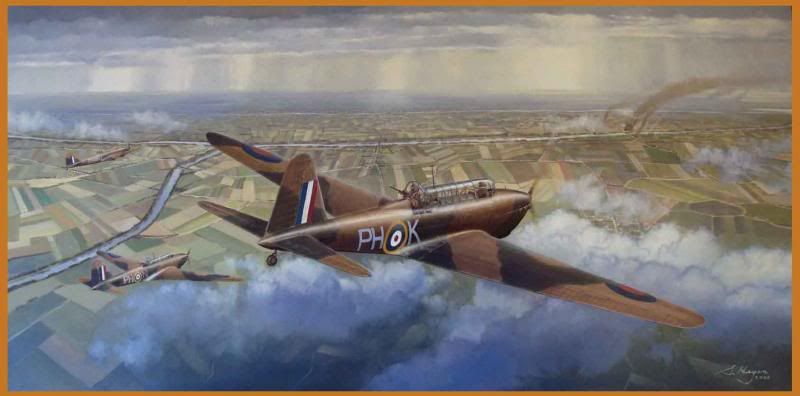
The painting is titled “Unquestionable Courage,” and depicts the air assault approaching its target. The painting is by Steve Heyen; the original is in a private collection.
Fairey Battle “PH-K” was shot down immediately after the bomb run, and all three occupants of the aircraft were either killed or died later in hospital.
Credit for the degree of success the mission attained was attributed to the leadership of Flying Officer Garland and the “coolness and resource” of Sergeant Gray, whose navigation effectively brought the five-plane formation to the target.
It is said that Leading Aircraftsman Reynolds was denied the VC or any other commendation, because he was not in a decision-making position during the raid.
In addition to the loss of the Garland/Gray/Reynolds aircraft, three of the other Battles were shot down also, and only one survived to return to base. The crew of that Battle reported that the formation had additionally been attacked by Luftwaffe fighters after the completion of the bomb run.
Flying Officer Garland had three brothers who also served in the RAF during the war. None of them survived.
The crew of “PH-K” is buried in Heverlee War Cemetery near Leuven, Belgium.

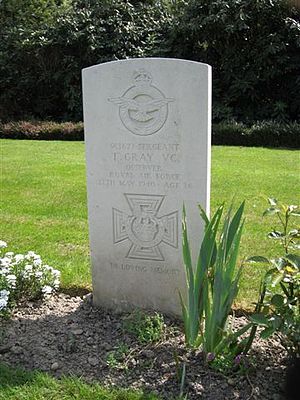
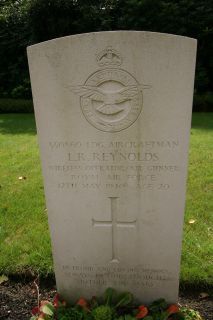
The London Gazette published the notice of the awards of the Victoria Cross for the two airmen on 11 June, 1940. The citation notes their “most conspicuous bravery.”
Sources:
http://www.bomber-command.info/vcgarlandvcgray.htm
http://en.wikipedia.org/wiki/Donald_Edward_Garland
http://en.wikipedia.org/wiki/Thomas_Gray_(VC)
http://www.scaleplasticandrail.com/kaboom/index.php/all-things-aviation/172-176-scale/kit-reviews/1081-172-victoria-cross-icons-boxed-set-from-airfix
http://www.warcemetery.eu/pagina38.html
http://www.stevenheyenart.com/